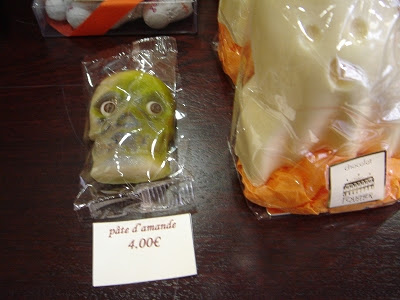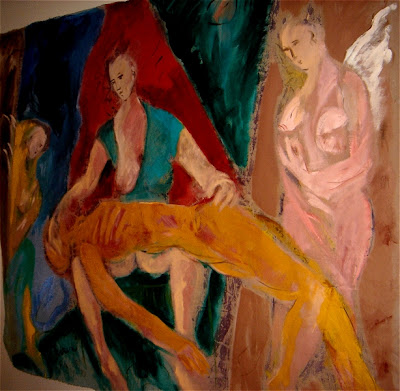“Mr. Witkin, I Presume”
 A shot of Witkin’s ‘What is poetry when we are so little’ from my Paris hotel balcony, Nov ’07.
A shot of Witkin’s ‘What is poetry when we are so little’ from my Paris hotel balcony, Nov ’07.Escaping from the darkness of the Channel Tunnel and rocketing down the track, I was full of anticipation. You see, even though I have great admiration for Joel-Peter Witkin’s work – I think some of his body of work as so iconic that they easily surpass the virtues of the supposed ‘greats’ of the 20th Century (‘Guernica’, ‘The Scream’, ‘The Perception of Time’, etc. ad nauseum) – I had never actually ‘seen’ a Witkin piece before.
Sure, there are so many jpegs of his photographs on the net, always easily accessible, but they are almost always so crudely compressed as to render the actual physical quality of work impotent. Indeed, there are programmes of his previous exhibitions popping up on eBay and Amazon all the time, containing a broad selection of his controversial work, but the lack of scale and pristine gleaming of every sinew is not to be found here in these printed tomes.
No. I had never truly ‘seen’ Witkin’s work for myself; as in an original gallery work, confronting me one-to-one ‘in the flesh’ as it were.
If you think you are not familiar with Witkin’s work, you probably are but don’t realise it. His work moulds the objectifying of the dead human form into a classical, almost renaissance style of idolatry. Add to that an air of Victorian brutalism and bizarre Weimar-esque characters and you have a unique, unforgettable experience in almost every black and white slate. His body of work was famously pilfered for use in the 1994 Nine Inch Nails video for ‘Closer’, which admittedly became successful and influential in its own field. Witkin photographs subjects in the same way Bacon paints them, exposing and embellishing their unpleasant attributes in such a way that turns them into objects of beauty or fascination.
See the NiN video of robbed Witkin imagery here (Vimeo).
This anticipation of mine was in danger of turning into a real problem. Alighting the Eurostar for this brief mid-week trip to the heart of Paris, I was in a complete daze; wandering around the Metro stations with no clear direction, mumbling sentences from my ‘Paris for Dummies’ phrasebook to snorting passersby, and getting quite lost on the underground in the process. Suddenly finding myself virtually by accident outside, and in the clear cold daylight on a typically busy Parisian street, I gathered my bearings and made my way to the Opera De Noailles hotel.
Almost immediately I started seeing the signs warning me of the obscenities ahead. I noticed the macabre omens somehow mocking me, the Fates nodding in my direction with barely concealed glee. I started noticing grotesque imagery everywhere. Halloween confectionary was still out on display in the shops here in Paris, for some reason, with green marzipan skulls and pure white fondant ghosts grimacing at me through the windows – all sharing a private joke I was clearly not privy to. What did they know that I didn’t?
 A Parisian sweet shop. Paris Nov 07.
A Parisian sweet shop. Paris Nov 07.
Getting to my hotel and checking in, I couldn’t help but notice a massive oil painting in the corner of the lobby area, depicting an angel fondling her right breast while standing over a slightly dessicated corpse. Was this one warning too many? A clear portent of the unholy grimness to come later that night, maybe?

The Opera De Noailles hotel. Paris.
Still in this murky daze of anticipation I scurried up to my room and immediately prepared myself for the two mile walk to the Baudoin Lebon gallery, for the 6pm opening of Witkin’s latest work. A quick shower revealed my darkest fear – the city had already possessed my soul. I had been in Paris for only the briefest amount of time and my nose was already crammed with jet-black soot. As a country bumpkin, I was not used to this. Something was happening to me, I thought. It was no dream.
I left the hotel sharpish and easily located the gallery on Rue Sainte Croix de la Bretonnerie. Or rather, it found me. The door to the premises gaped wide open into the dark Autumn night, the blinding white light from within attracting me from afar like a moth to a flame. Or a Siren to the rocks, perhaps?
Before I knew it I was amongst the crowd of fellow visitors and curious enthusiasts of ‘dark art’, each seemingly as over-awed by grim spectacle upon grim spectacle as I. Walking up to one of the first Witkin photographs in this collection, ‘The Raft of G. W. Bush’, my anticipation reached a plateau and I eased into a relaxed state of wonder and amusement in equal measure. You see, there is a great amount of humour to be found in Witkin’s work – you just have to dare yourself to laugh.
Wandering from George Bush’s sinking raft to each of the other paintings, I was struck by the variety of emotions and feelings they betrayed. Sure, there was the shock and awe you’d expect from most of the pieces, and of course there is an obvious grimness to the dead baby (‘Pathologist’s Window’), putrified heads (‘Ars Moriendi’ – my favourite piece of the exhibition), and various body parts that litter Witkin’s world. But there is also pathos to be found here, a delicate wistfulness, a sense of sadness, a feeling of absurdity about the bodily frame, and the afore-mentioned humour is there in abundance. Have you ever noticed how the human penis looks so utterly ridiculous? How the ribcage looks so perfect that it is as if nature intended it to be seen exposed and situated outside of the body?
And then, amongst the freaks and uniques, mixed in with the dead and the decayed, there was him. Joel-Peter Witkin, standing there in the middle of the gallery all rosy and jolly, dressed in what looked like Dali’s lost purple pyjamas. Like Doctor Who’s lovably eccentric offscreen father. I hadn’t seen a recent photograph of him (the last one I saw was shot in the mid-nineties), but there was no mistaking that nose. Those eyes. Those whiskers. The fact there were video cameras all around him helped clarify his identity too, of course.
This gallery exhibition entitled ‘Human Kind’, running now until December 8th, was the end of the road in a sense, the last scene of his dvd documentary is shot here in this busy room of the exhibition as I watch on, before he packs his bags and leaves the city for his next abominable project of distressed human forms.
Walking over to Witkin and introducing myself, I felt like I had just wandered through a dense jungle of doom to reach this very point – traversing a landscape of scorched trees with branches of babies’ arms and legs, matted grass of old women’s hair, blood-red flowers of eyes and teeth – to reach his distant outpost, his accursed territory of grim delights, and look him square in the eye. Human-to-human. It was then, at that point, that I kind of spoilt the moment by thrusting my tattered copy of his San Francisco 1985 exhibition programme into his hand for an autograph. Well. I am a fan after all.
You’d be forgiven if all this sounds sycophantic, but you’d be wrong I’m afraid. Like a lot of fans of Witkin’s work, I demand new experiences and sights on every single piece of work he does. When I perceive him to fail this absurdly high expectation, and sense that he is coasting when he should be roasting, I am indeed highly critical. Too much activity crowds some of his works for my liking, and I wish he’d venture into vast outdoor spaces a bit more, for instance (like his mysterious ‘The Earth is blue like an orange’, slightly reminiscent of Bergman’s ‘Seventh Seal’). Some of his best works, in my opinion, feature a lone grotesque element left to breathe in a spacious frame, uncluttered by dead apes, Victorian cameras, or religious paraphernalia (yes, even the Witkin Horrors can be lampooned). But, hey, that’s my personal view. One of the main reasons I like this exhibition’s ‘Ars Moriendi’ is because of its deceptively simple set-up and symmetry. Grossly putrifying decapitated heads mostly nestle on the bottom of the frame, shouting enviously upwards to the beauty above as she caresses their pustulated and blackened brows with a feather fan. Sheer, uncluttered genius. Witkin at his very best and at his peak.

A shot of ‘Ars Moriendi’ by Joel-Peter Witkin, in exhibition.
After sharing a few thoughts about his work, and about how his peculiar knack of uncovering beauty in the ugly and repellent is a big inspiration to me and my own work, he was off into the crowd once again, meeting and greeting everyone in the room who dared approach him with gleeful geniality and kindness. For someone who deals regularly with pickled foetuses and severed penises, it seemed almost criminal that he was clearly having so much fun. Walking around the exhibition one last time, viewing his works of so-called depravity and degradation with now satiated anticipation, you know what? I had fun too.
Pb.
You can see more images from the exhibition here, though I recommend you take a trip to see it in person before it ends in December;
http://www.baudoin-lebon.com/fiche-oeuvre1.php?num=20752
Find out more about Joel-Peter Witkin here;
http://en.wikipedia.org/wiki/Joel-Peter_Witkin
 My close-up of Witkin’s plan for ‘Bad Student’, in exhibition.
My close-up of Witkin’s plan for ‘Bad Student’, in exhibition.
